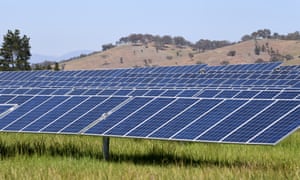Extract from The Guardian
The
Australian National University has been making headlines for its
analysis that, with the current rate of renewable energy growth,
Australia will achieve its Paris agreement targets five years early – by
2025. Unfortunately, after a careful review, we find their analysis doesn’t stack up.
The ANU briefing note has surprised, if not shocked, many in the expert and analytical community with detailed knowledge of Australia’s climate and energy policy.
Numerous international and national efforts to examine Australia’s climate and energy policy have all concluded that the government will not reach, on present policy settings, the 26-28% reduction from 2005 levels by 2030 it has put forward under the Paris agreement.
To achieve a 26% reduction below 2005 levels in national emissions –
the lower end of Australia’s Paris agreement target – would require
about a 75% penetration of renewables in the power sector by 2024,
whereas the ANU scenario projects 50%, which is not enough to reach the
Paris target.The ANU briefing note has surprised, if not shocked, many in the expert and analytical community with detailed knowledge of Australia’s climate and energy policy.
Numerous international and national efforts to examine Australia’s climate and energy policy have all concluded that the government will not reach, on present policy settings, the 26-28% reduction from 2005 levels by 2030 it has put forward under the Paris agreement.
The ANU briefing, possibly inadvertently, creates the impression that all that would be required is a continuation of the recent rate of renewable energy deployment. That is simply not the case, not without major policy interventions, which are unlikely – at least under the current government.
The government’s claim that the ANU briefing note shows it will achieve the Paris agreement targets “at a canter” is manifestly false. The rapid and continued rollout of renewable energy into the power sector assumed in the ANU briefing paper is something that the Australian government actually opposes.
The government’s policies are aimed at slowing the renewable energy rollout, and in particular maintaining coal in the power sector at any scale, which essentially contradicts the premises of the ANU paper.
The present large and increasing rollout in the utility sector is driven by the renewable energy target. Given that this expires in 2020, that specific economic incentive will disappear.
While the penetration of 50% renewables by 2025 may be plausible in the absence of further policy developments, it is not considered plausible that close to 90% penetration could be achieved by 2030 without substantial policy action.
Such reductions would also require phasing out coal almost completely from the power sector by 2030, which is clearly not supported by a federal government that is currently trying to promote more coal power, not less.
While the low cost of new renewable supply is also a clear driver, market barriers are already in evidence, along with grid connection issues that require active intervention.
As the ANU briefing note argues – and as is shown in peer reviewed studies (including by the authors of the briefing note) – achieving renewable energy penetration rates in the power sector at this scale by 2030 is technically and economically feasible.
However, there is a consensus in the expert community that these levels of penetration will not be achieved without further policy and grid development. An effective exit of coal from the power sector in Australia by 2030 would be one of the necessary steps in achieving this.
There is a very important role for renewable energy in the non-power generation sectors, such as industry, mining and agriculture. While the recent growth rate of renewables in Australia’s power sector has been high by world standards, it is also the case that the penetration of renewable energy into Australia’s total primary energy supply has not progressed rapidly and is relatively stagnant. This would need to change for Australia to meet the Paris agreement goals, and as a further major opportunity for the renewable industry.
The government’s own projections, updated most recently in December 2018 with present policies, show that by 2030, emissions will be at only 7% below 2005 levels.
Emissions from other sectors underestimated
The other explanation for the ANU’s anomalous finding is what appears to be a substantial underestimation of the ~70% of national emissions outside of the power sector – the emissions from direct combustion, transport, fugitives, agriculture, industrial processes, waste, and land use and forestry (LULUCF).This is important, as the power sector only accounts for about 34% of national emissions (and declining), and overall emissions from these other sectors are growing.
The ANU assumes an average increase from these sectors of 2 MtCO2e per year. However, government projections indicate this increase is likely to average around 5.4 MtCO2e a year, on average, to 2024 or 2025, and then about 4.0 MtCO2e per year to 2030 (all from post 2018).
Given the underlying lack of policy, the historical growth rates and the trends in efficiency improvements of emissions in these sectors, the government projections look reasonable. The reduction rates the ANU paper assumes are far below any reasonable estimate.
Finally, it is also worth noting that the Paris agreement targets put forward by the Australian government are insufficient to meet the agreement’s 1.5°C long-term temperature goal. The Paris agreement would require reductions of 45- 60% by 2030 for the whole economy.
• Bill Hare, a physicist and climate scientist, is the managing director of Climate Analytics

No comments:
Post a Comment